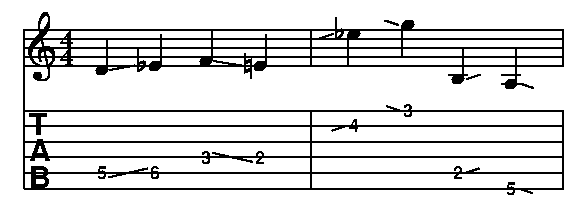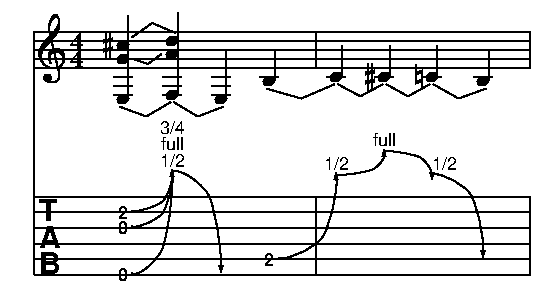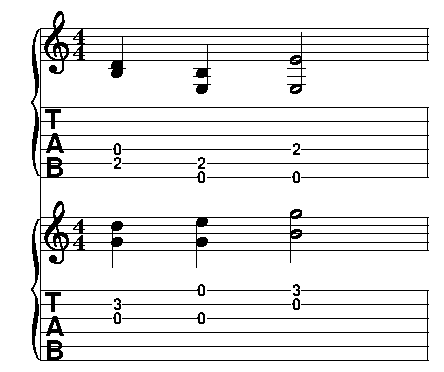<-- previous page Table of Contents Index next page -->
Mup can print tablature staffs. Tablature notation is commonly used for guitar and several other instruments. Mup supports tablature for 1 to 9 strings.
Mup will automatically create a normal 5-line staff above each tablature staff, giving the equivalant music on that staff. This staff will be referred to as the "tabnote staff." Normally, you will input music just for the tablature staff, and the tabnote staff will be derived from that. However, for any given measure, you can explicitly input music for a tabnote staff, which will turn off the automatic translation for that measure. If you only want either the tab or tabnote staff to be printed, you can mark the other one as invisible (see the "visible" parameter). You should specify the appropriate clef and key signature for the tabnote staff, so that Mup can make the best derivation.
To set up a tablature staff, you use the
stafflines parameter.
To get a standard 6-line guitar tablature staff, you can just say
score staffs=2 staff 2 stafflines = tab
If you want tablature for an instrument other than a 6-string guitar with
standard tuning, you specify
the pitches of the strings from top to bottom
within parentheses after the "tab." For example:
stafflines = tab (e a d& g)
stafflines = tab (e5 b g d a3 e'3)
score staffs = 2 staff 2 stafflines = tab
score staffs=2 staff 2 stafflines = tab (e5 b g d a3 e'3) staff 1 ifdef MIDI transpose = down perfect 8 endif
Mup should be able to handle almost any instrument with up to 9 strings.
Several strings can have the same pitch; you just need to distinguish
them with ' marks.
The strings must be listed in whatever order the strings are to appear
on the tablature staff.
As another example,
stafflines = tab (g3 d3 a2 e2)
The list of strings, if any, can optionally be followed by y or n. Using y will cause the word TAB to be printed vertically at the beginning of every score. Using n will cause that to never to be printed. Not specifying either will cause it to be printed only on the very first staff, which is the most common way of printing tablature.
Input of tablature is similar to that on regular staffs. Each note in a
chord is specified by a string and a
fret.
So fret 3 on the g string
is designated by g3, or fret 0 on the e' string is designated by e'0.
If your open string pitch includes an accidental, that would be included
as well, so if you had an instrument with an f# string and wanted to
play the 6th fret on that string, it would be f#6.
Fret numbers can range from 0 to 99.
If you want fret numbers to be placed inside parentheses,
put parentheses
around them in the input.
You can also put both the string and fret within a set of parentheses,
in which case, the note generated on the tabnote staff will have parentheses
around it.
Here are some examples of chords:
2: d4; d5a3; b0 d(5); e2(b3)g2; bar

Time values
are specified just like on non-tablature staffs: a number
optionally followed by one or more dots (like 4 or 8..),
or a list of such numbers added together (like 2+8),
preceding the chord pitches. Tablature staffs follow the same
rules as non-tablature staffs for using time values from the previous
chord if no time value is specified on the current chord. Similarly,
if no notes are specified for a chord, the same notes used in the previous
chord are reused. As an example:
2: 4.e5; ;8;b2; bar

Rests and spaces can be specified with r and s, just like on non-tablature staffs. They result in nothing being printed on the tablature staff, and rest or space being printed on the tabnote staff.
Any chord on a tablature staff can be preceded by a list of chord attributes in brackets, just like with non-tablature staffs. If you want a chord to be printed with X (for a muffled string) rather than a fret number, use [xnote]. In this case, the fret number will be used only to determine where to put the X on the tabnote staff, and what note to use for MIDI. Using [diam] will have no effect on the tablature staff, but will cause diamond notes to be used on the tabnote staff. Using [grace] or [cue] will cause the fret numbers to printed in a smaller size, and the corresponding notes on the tabnote staff to be printed in a smaller size. Using [slash N] will cause N slashes to be printed below the chord on the tablature staff, as well as slashes on the corresponding chord on the tabnote staff. You can use the other chord attributes (with, pad, and =tag) just like on a non-tablature staff.
From an input point of view, ties work much the same on tablature staffs as on other staffs. On output, tie marks on tablature staffs are normally not printed, and the frets are not printed on the tied-to chord. If a tie goes across to a new score, the frets are printed, but in parentheses, to indicate the chord is really just the continuation of a tie.
In Mup input,
slides are shown with <>, rather like
slurs
on non-tablature staffs.
There is a special variation used for slides that come from nowhere in
particular or go to nowhere in particular.
These are shown with <\n>, </n>, <n\>, or <n/>.
A slide is indicated on output on tablature staffs
as a slanted line between 2 fret numbers on a string.
On tabnote staffs, they as drawn as a slanted line between 2 notes.
See the examples below:
2: a5<>; a6; d3<>; d2; bar 2: b4</n>; e3<\n>; a2<n/>; e'5<n\>; bar

A bend (stretching a string to make it sound higher than normal)
is specified on tablature staffs
by putting a text string after the string. The
text string can be the word "full" or a number and/or fraction.
Some examples:
2: e4 "full"; e "1/2"; 2e "1 1/2"; bar

If you want to bend back down to having no bend (a release), the text string specifying the bend is just an empty string of "". Note that if both a fret and bend other than "" are specified, this indicates a prebend, whereas if only a bend is specified, this indicates a normal bend.
Bends need not be a whole number of half steps, but if you specify a bend that falls between half steps, when it is used on the tabnote staff, the bend is rounded to the nearest half step, or rounded downward if it is exactly in the middle of a half step. When possible, bends of 1/4 step or less are shown on the tabnote staff by a small curve rather than by a separate note.
You can specify bends on more than one string at once, but a continuation
bend (bending to a new distance without replucking the string) is only
allowed on a single string at a time. Here are some examples:
2: g0b2e'0; e' "1/2" g "full" b "3/4"; e' ""; a2; bar 2: a "1/2"; a "full"; a "1/2"; a ""; bar

If you have more than one voice on a tablature staff, bends on other than the top voice may collide with other voices in some cases, and if there are bends from more than one voice simultaneously, they may collide.
On non-tablature staffs, bends are specified with a ^ symbol followed
by the note to bend to. The note to bend to is specified by letter and
optional octave (accidentals are not specified). If you want just a small
bend (1/4 step), this is specified by ^/. For example:
1: e ^f; f; b ^c5; c#5; bar 1: d+^e+ g^a; e+a; g ^/; c ^/ c+^/; bar

Note attributes of ~ for tie, ? for a small note, and = for a tag work the same on tablature staffs as on non-tablature staffs.
If bm, ebm, esbm, abm, or eabm are given on tablature staffs they are transferred to the tabnote staff and used for custom beaming or automatic beaming there, as appropriate. Items in "with" lists inside [ ] are also copied to the tabnote staff. In general, unless otherwise specified here, if you want items such as tempo and dynamic marks to appear on both tablature and tabnote staff, you have to specify them for both staffs.
The "alt" inter-chord attribute is not allowed on tablature staffs.
When there is a tablature staff, the MIDI is actually generated from the tabnote staff. There are some limitations. Currently, no MIDI pitch bends are generated; slides and bends are instantaneous rather than gradual.
If a capo is being used, it probably better to declare a transposition of the tabnote staff rather than declaring the strings to be different notes. This is because most people would rather think of the original string letters when entering the tab staff information; and if you decide to put the capo on a different fret later, you only have to change the "transpose" line. The automatic MIDI octave transposition for standard guitar will also then still apply, on top of your transposition.
If you specify an octave mark (discussed in a later section) on a tabnote staff, the derived music will be printed with the notes raised or lowered the appropriate number of octaves to correspond to the given octave mark interval.
Since ties are not printed on tablature staff, and input notation for tablature slides is like what is used for slurs on ordinary staffs, if you want a curved line like a tie or slur on a tablature or tabnote staff, you have to use a phrase mark. See the section on phrase marks for more details.
The chord-at-a-time input style can also be used for tablature.
The staffs being mapped to from a single input line must either be
all tablature or all non-tablature, however.
score staffs=4 brace=1-2, 3-4 tabwhitebox=y staff 2 stafflines=tab staff 4 stafflines=tab music // The first two notes in each chord go to staff 2, // and the last two go to staff 4. [ 2; 2; 4; 4] : a2d0 g0b3; e'0a2 g0e0; 2 e'0d2 b0e3; bar
